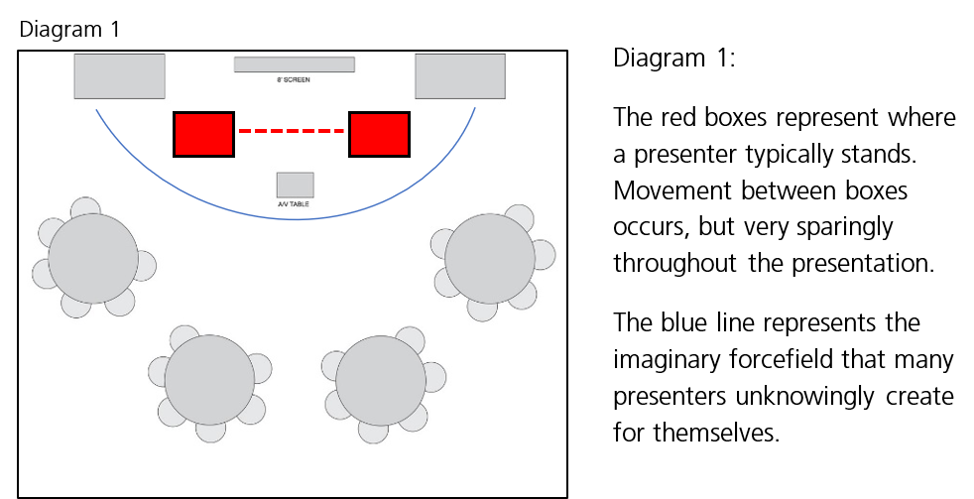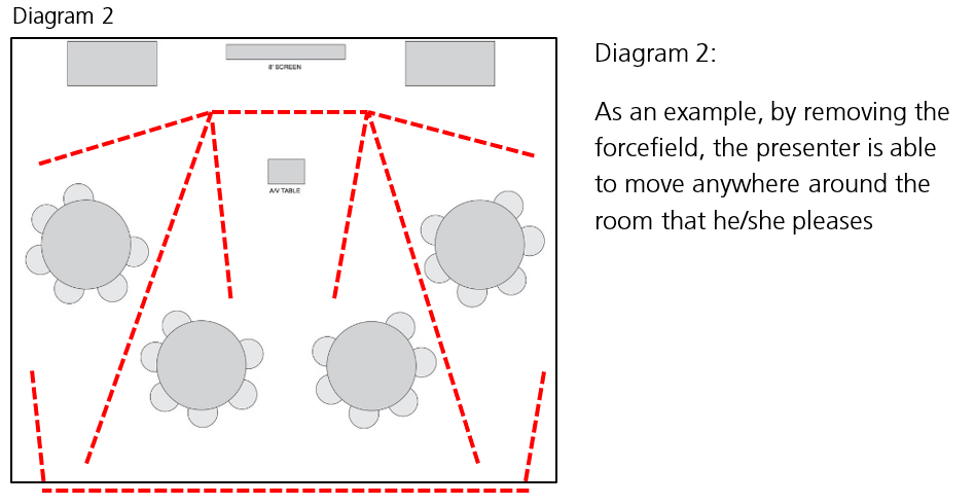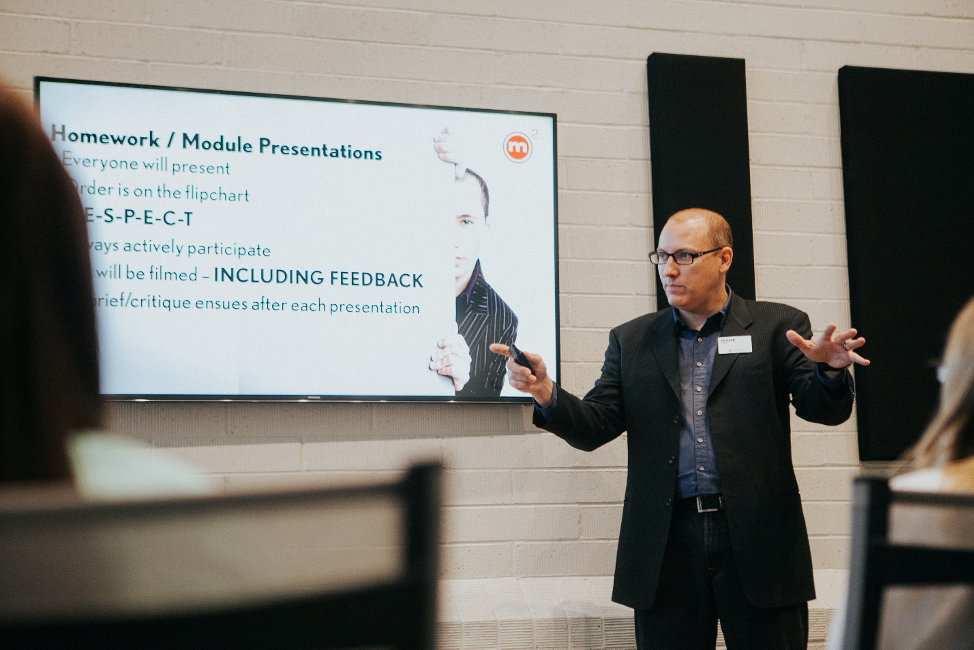Ditch the Podium and Engage Your Audience.
Presentation Hot Tip
If you’ve taken a course on public speaking in high school or college, the odds of you being taught to stand at the front of the room behind a podium are pretty high. It removes distractions, keeps your audience focused up front where the presentation is happening, and makes you look more professional… the list goes on.
These messages, along with countless others, have been communicated to hundreds of thousands of future presenters, meeting leaders, teachers, etc. But, what if they weren’t all true? What if movement, thoughtful and specific movement, actually enhanced the audience experience? What if it even made them more attentive?
In this post, we’ll discuss when—and when not to—use a podium. (Spoiler alert: There’s not too many times we’d recommend using one.) Along the way, we’ll suggest a few tips to help bring you out from behind the podium and deepen your connection with your audience.
First, the Case for Podiums.
This Photo by Unknown Author is licensed under CC BY-SA
First off, let’s clear the air: we at automätik are not “anti-podium” people. In fact, in some instances they are actually quite beneficial. Let’s say you’re the President of the United States giving a nationally televised speech, or an actor presenting at an awards ceremony, or a coach giving a press conference before a game… hey, bring out that podium!
OK, those are extreme examples, but they help prove a point: Podiums have a place and a purpose for very specific types of meetings, presentations, lectures, etc. Podiums can be useful for placing notes, laptops, tablets, or other content-related materials we use for recall throughout a presentation. They often times have a microphone affixed so we do not have to hold a wireless mic or wear one of those ill-fitting headsets worn by countless other “heads.” And they can make us feel safe, providing a place to rest our hands and hide whatever discomfort we may be feeling.
That said, we’d venture to say that in the vast majority of times a podium is used, it’s likely because it came with the room and/or we use it because it’s familiar and comfortable. The problem is, that comforting appendage is inhibiting your ability to connect with your audience in several important ways. Let’s break these down, starting with your most powerful asset: your body language.
Body Language is Key.
Albert Mehrabian, professor Emerytus of Pyschology at UCLA, and a pioneer on the study of non-verbal communication, asserts that approximately 55% of our communication is non-verbal. Wrap your mind around that for a minute: more than half of what people receive from you is being communicated by your body, not your words. In sharp contrast, only 7% of your communication are the actual words you speak!
Your posture, your facial expressions, your arm and hand movements, your eye contact, your smile… they are all doing more talking than the actual words that are coming out of your mouth! So, why hide your most powerful communication tool behind a podium?
Skip the Podium and Break the Forcefield.
OK, at this point, let’s assume that we’ve convinced you to at least consider getting out from behind the podium. What now? It is time to “break the forcefield.” This is probably the most important, but also the most nuanced, adjustment that we’d recommend. You see, even without the presence of a podium, there is an imaginary line that most presenters never cross. While your mileage may vary, it typically looks something like this:

Notice where both of the zones are located? They are strategically placed on either side of the screen to eliminate blocking a participant’s view of the screen but providing line-of-sight for the presenter to see his/her on-screen material.
At first glance, you may think that is totally fine because most of the people you’ve seen present confine themselves similarly. And, we bet you can recall times when you’ve done the same thing, right? But why do we do that to ourselves? Think about it, by placing yourself at the very front of the room, you’ve created two big problems:
- You have to turn sideways (away from your audience) to see what’s on the screen.
- You’ve restricted your movement to two small spaces; two small “boxes.”
Now imagine if we removed the imaginary forcefield and opened up the whole room for the presenter to move around in. Here is an example of what that might look like.

As you can see, removing the “forcefield” frees you up, allowing you as the presenter to move anywhere you please. The room becomes your stage instead of the pre-determined, unknowing, small zones that previously held you captive. Now, let’s shift gears and discuss how the right types of movement will boost audience engagement.
You’re Free to Move About the Cabin. Now, Move with a Purpose.
So, you’ve removed the forcefield, but does movement actually have a positive impact on your audience and your message? The answer to that is yes… if done with a purpose. Let’s break down a few ways that movement can elevate your connection to your audience…
- Intentional movement keeps the spotlight on you. If you plant yourself in one place at the front or side of the room, your audience is more likely to get distracted, become bored, get tired, etc. By moving around the room, they have to shift their bodies in their seats to follow you. Additionally, when you walk closer towards someone, their attention is heightened because they are processing your movement.
- Movement amps up your non-verbal communication. You become more visible to everyone in the room as you move around. For example, audience members with a back-row seat will receive a better view of your body language.
- Movement can make you look like a pro. Movement can also increase the perception of your comfort and mastery of the material. The right movement can make a huge impression on your audience’s belief in how skilled you are.
- Movement boosts your energy. Leading a presentation puts your brain and body on overdrive, so you need to keep your energy up! Here’s a quirky but apropos analogy: Groomsmen and bridesmaids are asked to bend their knees from time to time during a wedding to keep their blood flowing; similarly, presenters need to do the same thing. Standing still for long periods of time is exhausting and quite unnatural for you and your audience. Movement will not only make you feel better, it will make you look more natural.
- Movement is a great memory trigger. And lastly, movement can actually put you in a better position to see the screen without having to turn your back on the audience. We all need to look at the screen from time to time for a reminder of where we’re at and what we’re supposed to say; but turning your back to your audience to do that is a cardinal sin. By placing yourself strategically around the room, you can actually read the screen while still keeping positive non-verbal communication with your audience.
And a Word of Caution: Not All Movements are Created Equal.

As you can see, we are staunch advocates of ditching the podium, breaking the forcefield, and moving around your presentation space. However, we need to insert a few presentation caveats here. First, let us say that the wrong kinds of movement can have an adverse effect. For example, if your pace is too quick or too calculated, or your hands and arms are flying around like your swatting at bees, you can actually distract your audience, and lessen the impact of your message. A great to way to avoid these red flags is to intentionally practice strategic movements during your rehearsal time. Better yet, invite a trusted colleague to view your rehearsal and ask them to evaluate your body language and movements.
Say Goodbye to the Podium and Start Your Journey Today.

The bottom line is that the more you practice movement in your presentations, the more natural it will become to you. We encourage you to take some baby steps. Start by simply stepping away from the podium and trying to break the forcefield while you’re talking and move around the room a bit. See what feels comfortable and what doesn’t. Take notice of how your audiences reacts as you move. We think you’ll be waving that podium “goodbye” in no time.

